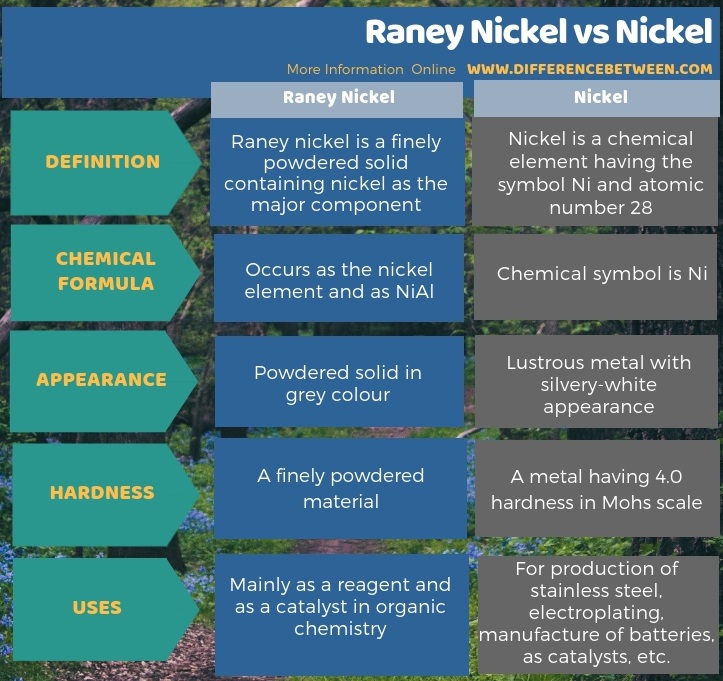The key difference between Raney nickel and nickel is that Raney nickel is a mixture of several chemical elements whereas nickel is a chemical element we categorize as a metal.
Raney nickel is a well-known term as a catalyst in organic chemical synthesis reactions. However, nickel is a metal and Raney nickel is a finely powdered solid which has nickel as the major component.
CONTENTS
1. Overview and Key Difference
2. What is Raney Nickel
3. What is Nickel
4. Side by Side Comparison – Raney Nickel vs Nickel in Tabular Form
5. Summary
What is Raney Nickel?
Raney nickel is a finely powdered solid containing nickel as the major component. A synonym for this compound is “spongy nickel”. The nickel in this material originates from nickel-aluminium alloys. There are several grades of Raney nickel, but the common one is the grey solid. Some grades of this material are pyrophoric. That means; it can undergo ignition spontaneously. We use this material mostly as air-stable slurries. The American engineer Murray Raney discovered this material.

The most common application of this material is as a catalyst. Moreover, it is sometimes used as a reagent in organic chemistry.
Production
When considering the production of Raney nickel, there are two steps as follows:
Alloy preparation
First, we need to prepare the aluminium-nickel alloy. We can do this by dissolving nickel in molten aluminium. After that, we need to cool (quench) the reaction mixture. During this cooling, we can add some other metals such as zinc or chromium. Importantly, the addition of other metals enhances the activity of the resulting catalyst. Therefore, we call this added material as the promoter.
Activation
In this process, we need to finely powder the alloy. Then we need to treat the powder of the alloy with a concentrated sodium hydroxide solution. It gives sodium aluminate. After that, we need to leach out aluminium as either NiAl3 and Ni2Al3. Most of the nickel remains in the form of NiAl. Then we can remove any remaining sodium aluminate by washing the product with distilled water.
What is Nickel?
Nickel is a chemical element having the symbol Ni and atomic number 28. It is a lustrous metal with a silvery-white appearance. It is hard and ductile. We categorize this metal as a transition metal. Since an oxide layer forms covering the metal, nickel is usually less reactive. But, if we finely powder the metal, the surface area increases, increasing the reactivity of the metal as well. Moreover, this metal is slowly oxidized by oxygen; thus, we consider it as a corrosion-resistant metal.

Moreover, this metal is ferromagnetic at room temperature, which is unique for only four metals, others being iron, cobalt and gadolinium. The melting point of nickel is 1455 °C while the boiling point is 2730 °C. The common and most stable oxidation state of nickel is +2. This chemical element also acts as a mild base. The Mohs hardness of nickel is 4.0.
What is the Difference Between Raney Nickel and Nickel?
The key difference between Raney nickel and nickel is that Raney nickel is a mixture of several chemical elements whereas nickel is a chemical element we categorize as a metal. Moreover, when considering the appearance, Raney nickel appears as a powdered solid in grey colour while nickel is a lustrous metal with silvery-white appearance. So, this too is a significant difference between Raney nickel and nickel. Besides, we use Raney nickel mainly as a catalyst and nickel as an alloying metal.

Summary – Raney Nickel vs Nickel
Raney nickel is a finely powdered solid containing nickel as the major component while nickel is a chemical element having the symbol Ni and atomic number 28. The key difference between Raney nickel and nickel is that Raney nickel is a mixture of several chemical elements, whereas nickel is a chemical element that we categorize as a metal.
Reference:
1. Ross, Julian R.h. “Environmental Catalysis.” Contemporary Catalysis, 2019, pp. 291–314., doi:10.1016/b978-0-444-63474-0.00013-8.
Image Courtesy:
1. “Dry Raney nickel” By Rune.welsh (CC BY-SA 3.0) via Commons Wikimedia
2. “Nickel kugeln” By René Rausch – Own work (CC BY-SA 3.0) via Commons Wikimedia
ncG1vNJzZmivp6x7pbXFn5yrnZ6YsqOx07CcnqZemLyue8OinZ%2Bdopq7pLGMm5ytr5Wau26%2BwKecsmWenrCssctmmKecXaO2pLfEpWY%3D